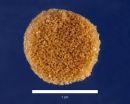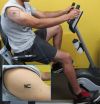(Press-News.org) Porphyrin molecules are essential to many biological processes, such as photosynthesis and respiration. Dr. Wilhelm Auwärter's group is investigating these all-round talents at TU München.
Normally, hydrogen attaches to the outer edges of the porphyrin core – named porphine, but other chemical entities can take the place of hydrogen, thereby changing the properties of the molecules.
Alissa Wiengarten, PhD student at the TUM Department of Physics, heats a porphine powder in a vacuum chamber. In the process, individual porphine molecules leave the collective and adhere to a silver surface, where they react with each other and assemble into small groups – all by themselves. Single molecules can desorb from the hot surface, while chains of two, three or more porphine units cannot. In this way the scientists were able to assemble chains of up to 90 porphine units.
Thorough analysis
Using a surface made of silver is essential to the experiment: "Silver seems to be a kind of catalyst for the reaction", Wilhelm Auwärter explains. "Still, we don't fully understand why this is the case."
Aside from fundamental questions, Auwärter's group also hopes to find a way to generate ordered long molecular porphin chains, so-called tapes. Only one molecule wide, such structures could serve as optically active elements in electronic applications or data storage.
In order to investigate these tiny structures on the silver surface, Auwärter's team uses a whole range of sophisticated structure analysis techniques available at TUM and through cooperation with international partners.
Fascinating images of the molecular structures, for example, were captured using a scanning tunneling microscope at TUM. The team also conducted spectroscopy analyses using synchrotron radiation of the ELETTRA storage ring in Trieste, which provided important insights into the electronic structure of the porphine groups.
INFORMATION:
About the project:
The work was funded by the ERC (Advanced Grant MolArt), by the German Research Foundation (DFG) (Cluster of Excellence Munich Center for Advanced Photonics (MAP) and Technische Universität München's Institute for Advanced Study), a Marie Curie Intra-European Fellowship and the International Max Planck Research School of Advanced Photon Science (IMPRS-APS), as well as the Japanese International Center for Young Scientists (ICYS) and the International Center for Materials Nanoarchitectonics (MANA). The synchrotron experiments were carried out at the Helmholtz-Zentrum Berlin's electron storage ring BESSY II and the Materials Science Beamline of the synchroton facility ELETTRA in Trieste (Italy).
Flexible tapes from the nanoworld
Chemical reaction yields 'tapes' of porphin molecules
2014-08-13
ELSE PRESS RELEASES FROM THIS DATE:
Teachers play key role in program to fight childhood obesity
2014-08-13
An innovative physical activities guide developed at the Frank Porter Graham Child Development Institute (FPG) is helping North Carolina fight childhood obesity. New research shows that when teachers direct these physical activities, young children become more active and less sedentary.
"In the past twenty years, childhood obesity rates have skyrocketed," said FPG investigator Allison De Marco. "And for the first time in over a century, children's life expectancies are declining because of increased numbers of overweight kids."
De Marco said these statistics are especially ...
Researchers uncover clues about how the most important TB drug attacks its target
2014-08-13
Researchers at the Johns Hopkins Bloomberg School of Public Health say they have discovered a new clue to understanding how the most important medication for tuberculosis (TB) works to attack dormant TB bacteria in order to shorten treatment.
The antibiotic Pyrazinamide (PZA) has been used to treat TB since the 1950s, but its mechanisms are the least understood of all TB drugs. The PZA findings may help researchers identify new and more effective drugs not only for TB – which can require six months or more of treatment – but other persistent bacterial infections. A report ...
Hurricane Julio and 2 tropical lows 'bookend' Hawaii
2014-08-13
Infrared satellite imagery from NOAA's GOES-West satellite shows three tropical system s in the Central Pacific Ocean that appears like bookends with Hawaii in-between.
In an infrared image from the GOES-West satellite taken August 13 at 1200 UTC (8 a.m. EDT/2 a.m. HST), Hurricane Julio lies to the north of Hawaii, while two low pressure areas lie to the southeast of the island state. The image was created by NASA/NOAA's GOES Project at NASA's Goddard Space Flight Center in Greenbelt, Maryland.
On August 13 at 0900 UTC (5 a.m. EDT/11 p.m. HST on Aug.12) the center of ...
How useful is economics -- how is economics useful?
2014-08-13
What insights do the models, experiments and econometric regressions of scientific research provide about the economy – and why and under what conditions are they useful in dealing with real-world problems? This question will be overarching the discussions among 17 Nobel Laureates in Economic Sciences and approximately 450 aspiring young economists from more than 80 countries in Lindau, Germany, next week. The 5th Lindau Meeting on Economic Sciences will bring them together for a unique dialogue across generations, cultures and scientific backgrounds. The meeting will open ...
Many older emergency department patients are malnourished
2014-08-13
More than half of emergency department patients age 65 and older who were seen at UNC Hospitals during an 8-week period were either malnourished or at risk for malnutrition.
In addition, more than half of the malnourished patients had not previously been diagnosed, according to a new study by researchers at the University of North Carolina at Chapel Hill. The study was published online August 13 by the journal Annals of Emergency Medicine.
"Malnutrition is known to be a common problem among older adults. What is surprising in our study is that most of the malnourished ...
Reduction of tau protein improves symptoms in model of severe childhood epilepsy
2014-08-13
Researchers at the Gladstone Institutes have shown that reducing brain levels of the protein tau effectively blocks the development of disease in a mouse model of Dravet syndrome, a severe intractable form of childhood epilepsy. This therapeutic strategy not only suppressed seizure activity and premature death, but also improved cognitive and behavioral abnormalities that can accompany this syndrome.
Previous studies from this group have shown that lowering tau levels reduces abnormal brain activity in models of Alzheimer's disease, but this is the first demonstration ...
'Shape-shifting' material could help reconstruct faces
2014-08-13
SAN FRANCISCO, Aug. 13, 2014 — Injuries, birth defects (such as cleft palates) or surgery to remove a tumor can create gaps in bone that are too large to heal naturally. And when they occur in the head, face or jaw, these bone defects can dramatically alter a person's appearance. Researchers will report today that they have developed a "self-fitting" material that expands with warm salt water to precisely fill bone defects, and also acts as a scaffold for new bone growth.
The team will describe their approach in one of nearly 12,000 presentations at the 248th National ...
Dust -- and the microbes hitching rides on it -- influences rain, climate
2014-08-13
SAN FRANCISCO, Aug. 13, 2014 — Dusty air blowing across the Pacific from Asia and Africa plays a critical role in precipitation patterns throughout the drought-stricken western U.S. Today, a scientist will present new research suggesting that the exact chemical make-up of that dust, including microbes found in it, is the key to how much rain and snow falls from clouds throughout the region. This information could help better predict rain events, as well as explain how air pollution from a variety of sources influences regional climate in general.
She will present a talk ...
Rooting out skin creams that contain toxic mercury
2014-08-13
SAN FRANCISCO, Aug. 13, 2014 — As countries try to rid themselves of toxic mercury pollution, some people are slathering and even injecting creams containing the metal onto or under their skin to lighten it, putting themselves and others at risk for serious health problems. To find those most at risk, scientists are reporting today that they can now identify these creams and intervene much faster than before. They're speaking at the 248th National Meeting & Exposition of the American Chemical Society (ACS).
The meeting, organized by the world's largest scientific society, ...
Tattoo biobatteries produce power from sweat (video)
2014-08-13
SAN FRANCISCO, Aug. 13, 2014 — In the future, working up a sweat by exercising may not only be good for your health, but it could also power your small electronic devices. Researchers will report today that they have designed a sensor in the form of a temporary tattoo that can both monitor a person's progress during exercise and produce power from their perspiration.
The team described the approach in one of nearly 12,000 presentations at the 248th National Meeting & Exposition of the American Chemical Society (ACS), the world's largest scientific society, taking place ...
LAST 30 PRESS RELEASES:
Post-stroke injection protects the brain in preclinical study
Cardiovascular risk score predicts multiple eye diseases
Health: estimated one in ten British adults used or interested in GLP-1 medications for weight loss
Exercise to treat depression yields similar results to therapy
Whooping cough vaccination for pregnant women strengthens babies’ immune system
Dramatic decline in new cases of orphanhood in Uganda driven by HIV treatment and prevention programs
Stopping weight loss drugs linked to weight regain and reversal of heart health markers
Higher intake of food preservatives linked to increased cancer risk
Mass General Brigham–developed cholera vaccine completes phase 1 trial
First experimental validation of a “150-year-old chemical common sense” direct visualization of the molecular structural changes in the ultrafast anthracene [4+4] photocycloaddition reaction
Lack of support for people on weight loss drugs leaves them vulnerable to nutritional deficiencies, say experts
Dogs’ dinners can have greater climate impact than owners’
Are you ready to swap salmon for sprats and sardines?
1.6 million UK adults used weight loss drugs in past year
American College of Cardiology comments on new dietary guidelines for Americans
American Society of Gene & Cell Therapy and Orphan Therapeutics Accelerator partner to advance and commercialize promising rare disease treatments
One in 14 patients having day case surgery have new or worse chronic pain 3 months after their operation
New study highlights link between eviction rates and gun violence
Heatwaves heat up soil but not toxin levels in rice, study finds
Digital modeling reveals where construction carbon emissions really come from
Turning farm waste into water filters
New study shows how the spleen helps the immune system accept a transplant
New Mayo Clinic study advances personalized prostate cancer education with an EHR-integrated AI agent
Researchers identify novel therapeutic target to improve recovery after nerve injury
Microbes in breast milk help populate infant gut microbiomes
Reprogramming immunity to rewrite the story of Type 1 diabetes
New tool narrows the search for ideal material structures
Artificial saliva containing sugarcane protein helps protect the teeth of patients with head and neck cancer
Understanding the role of linear ubiquitination in T-tubule biogenesis
Researchers identify urban atmosphere as primary reservoir of microplastics
[Press-News.org] Flexible tapes from the nanoworldChemical reaction yields 'tapes' of porphin molecules




